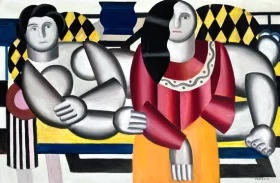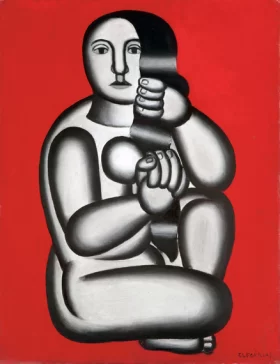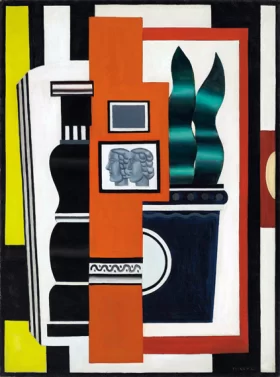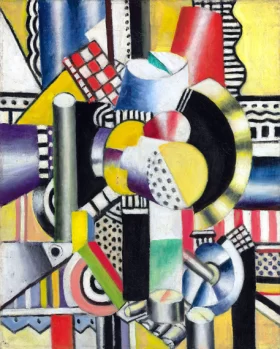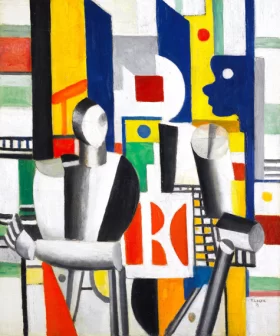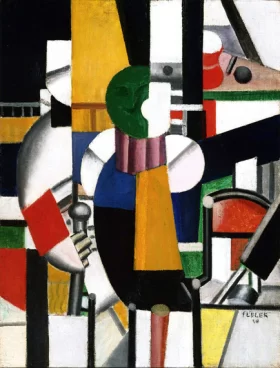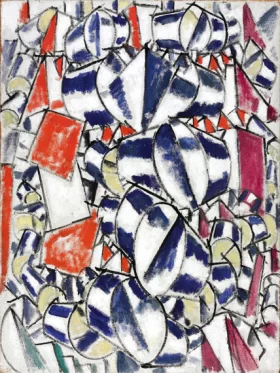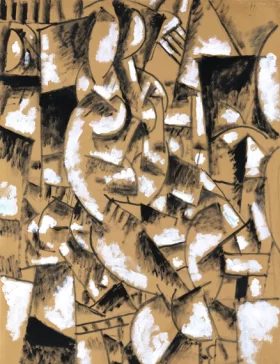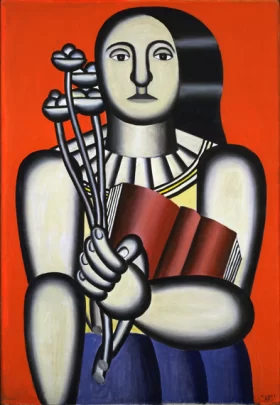只今全作品5%Off!! チェックアウト時にこのコードを入力してください!KMJP5
只今全作品5%Off!! チェックアウト時にこのコードを入力してください!KMJP5
フェルナンレジェ
Joseph Fernand Henri Léger (4 February 1881 – 17 August 1955) a French painter who was deeply influenced by modern industrial technology and Cubism. He developed “machine art,” a style characterized by monumental mechanistic forms rendered in bold colours. In his early works he created a personal form of cubism (known as “tubism”) which he gradually modified into a more figurative, populist style. His boldly simplified treatment of modern subject matter has caused him to be regarded as a forerunner of pop art.
Léger was born in Argentan, Orne, Lower Normandy, where his father raised cattle. In 1903 he enrolled in the Paris School of Decorative Arts; although he failed to get into the École des Beaux-Arts, he also began to study under two of its professors as an unofficial pupil, spending what he described as “three empty and useless years” studying with Gérôme and others, while also studying at the Académie Julian.. Léger was profoundly influenced by a retrospective of Paul Cezanne’s work at the Paris Salon d’Automne of 1907.
He began to work seriously as a painter only at the age of 25. At this point his work showed the influence of impressionism, as seen in Le Jardin de ma mère (My Mother’s Garden) of 1905, one of the few paintings from this period that he did not later destroy. A new emphasis on drawing and geometry appeared in Léger’s work after he saw the Paul Cezanne retrospective at the Salon d’Automne in 1907.
In 1908 Léger rented a studio at La Ruche (“The Beehive”), an artists’ settlement on the edge of Montparnasse and the seat of several avant-garde tendencies. He eventually met the painters Robert Delaunay, Marc Chagall, and Chaïm Soutine; the sculptors Jacques Lipchitz, Henri Laurens, and Alexander Archipenko; and the poets Guillaume Apollinaire, Max Jacob, Blaise Cendrars, and Pierre Reverdy. Through the poets, in particular, Léger gained a connection with the Cubist movement; many of them were close friends with Pablo Picasso and Georges Braque, the painters who had created Cubism in 1907.
At the time, Picasso and Braque’s Cubist style entailed fracturing forms into multiple intersecting planes; Léger adapted their techniques to break down forms into tubular shapes. In 1909 he produced The Seamstress, in which he reduced his colours to a combination of blue-gray and buff and rendered the human body as a mass of slabs and cylinders that resembled a robot and in 1910 he exhibited at the Salon d’Automne in the same room (salle VIII) as Jean Metzinger and Henri Le Fauconnier. In his major painting of this period, Nudes in the Forest, Léger displays a personal form of Cubism that his critics termed “Tubism” for its emphasis on cylindrical forms.
By 1913 Léger was painting a series of abstract studies he called Contrast of Forms. He created these paintings to illustrate his theory that the way to achieve the strongest pictorial effect was to juxtapose contrasts of colour, of curved and straight lines, and of solids and flat planes. Léger’s paintings, from then until 1914, became increasingly abstract. Their tubular, conical, and cubed forms are laconically rendered in rough patches of primary colors plus green, black and white, as seen in the series of paintings with the title Contrasting Forms. Léger made no use of the collage technique pioneered by Braque and Pablo Picasso.
During World War I, in which he fought as a sapper (military engineer) at the front lines, Léger acquired a new concern for making art accessible to the working classes. Léger’s experiences in World War I had a significant effect on his work. Mobilized in August 1914 for service in the French Army, he spent two years at the front in Argonne. He produced many sketches of artillery pieces, airplanes, and fellow soldiers while in the trenches, and painted Soldier with a Pipe (1916) while on furlough. In September 1916 he almost died after a mustard gas attack by the German troops at Verdun. During a period of convalescence in Villepinte he painted The Card Players (1917), a canvas whose robot-like, monstrous figures reflect the ambivalence of his experience of war.
This work marked the beginning of his “mechanical period”, during which the figures and objects he painted were characterized by sleekly rendered tubular and machine-like forms. Starting in 1918, he also produced the first paintings in the Disk series, in which disks suggestive of traffic lights figure prominently. In December 1919 he married Jeanne-Augustine Lohy, and in 1920 he met Le Corbusier, who would remain a lifelong friend.
In the mid-1920s Léger was associated with the French formalist movement called Purism, which had been launched by the painter Amédée Ozenfant and the painter-architect Le Corbusier. Purism was an attempt to strip Cubism of its decorative aspects; Léger consequently adopted flatter colours and bold, black outlines in his work. The “mechanical” works Léger painted in the 1920s, in their formal clarity as well as in their subject matter—the mother and child, the female nude, figures in an ordered landscape—are typical of the postwar “return to order” in the arts, and link him to the tradition of French figurative painting represented by Nicolas Poussin and Corot. In his Paysages animés (animated landscapes) of 1921, figures and animals exist harmoniously in landscapes made up of streamlined forms. The frontal compositions, firm contours, and smoothly blended colors of these paintings frequently recall the works of Henri Rousseau, an artist Léger greatly admired and whom he had met in 1909.
Combining the classical with the modern, Léger’s Nude on a Red Background (1927) depicts a monumental, expressionless woman, machine like in form and color. His still life compositions from this period are dominated by stable, interlocking rectangular formations in vertical and horizontal orientation. The Siphon of 1924, a still life based on an advertisement in the popular press for the aperitif Campari, represents the high-water mark of the Purist aesthetic in Léger’s work. Its balanced composition and fluted shapes suggestive of classical columns are brought together with a quasi-cinematic close-up of a hand holding a bottle.
As an enthusiast of the modern, Léger was greatly attracted to cinema, and for a time he considered giving up painting for filmmaking. In 1923–24 he designed the set for the laboratory scene in Marcel L’Herbier’s L’Inhumaine (The Inhuman One). In 1924, in collaboration with Dudley Murphy, George Antheil, and Man Ray, Léger produced and directed the iconic and Futurism-influenced film Ballet Mécanique (Mechanical Ballet). Neither abstract nor narrative, it is a series of images of a woman’s lips and teeth, close-up shots of ordinary objects, and repeated images of human activities and machines in rhythmic movement.
Starting in 1927, the character of Léger’s work gradually changed as organic and irregular forms assumed greater importance. The figural style that emerged in the 1930s is fully displayed in the Two Sisters of 1935, and in several versions of Adam and Eve. With characteristic humor, he portrayed Adam in a striped bathing suit, or sporting a tattoo.
In 1931, Léger made his first visit to the United States, where he traveled to New York City and Chicago. In 1935, the Museum of Modern Art in New York presented an exhibition of his work. In 1938, Léger was commissioned to decorate Nelson Rockefeller’s apartment.
During World War II Léger lived in the United States. He taught at Yale University, and found inspiration for a new series of paintings in the novel sight of industrial refuse in the landscape. The shock of juxtaposed natural forms and mechanical elements, the “tons of abandoned machines with flowers cropping up from within, and birds perching on top of them” exemplified what he called the “law of contrast”. His enthusiasm for such contrasts resulted in such works as The Tree in the Ladder of 1943–44, and Romantic Landscape of 1946. Reprising a composition of 1930, he painted Three Musicians (Museum of Modern Art, New York) in 1944.
Upon his return to France in 1945, he joined the Communist Party. During this period his work became less abstract, and he produced many monumental figure compositions depicting scenes of popular life featuring acrobats, builders, divers, and country outings.
After the death of Leger’s wife Jeanne-Augustine Lohy in 1950, Léger married Nadia Khodossevitch in 1952. In his final years he lectured in Bern, designed mosaics and stained-glass windows for the Central University of Venezuela in Caracas, Venezuela, and painted Country Outing, The Camper, The Constructors (1950), and The Big Parade (1954). Léger had hoped that these works, which depict the leisure activities of working-class people, would appeal to the general public, but they never achieved wide popularity. In 1954 he began a project for a mosaic for the São Paulo Opera, which he would not live to finish.
Fernand Léger died at his home in 1955 and is buried in Gif-sur-Yvette, Essonne.
Léger bequeathed his residence (at 108 Avenue du General Leclerc, Gif sur Yvette, Paris) to the French Communist Party, which later hosted negotiations of the Paris Peace Accords between the United States, Democratic Republic of Vietnam, Republic of Vietnam and the Republic of South Vietnam.
In May 2008, his painting Étude pour la femme en bleu (1912–13) sold for $39,241,000 at Sotheby’s and Contraste de formes (1913), which sold for $70 million at Christies in 2017.
Read more結果の1~100/387を表示しています

Étude Pour ‘La Femme en Bleu
By フェルナンレジェ¥49,049
Contraste de formes
By フェルナンレジェ¥47,329
Le grand déjeuner
By フェルナンレジェ¥50,769
Le corsage rouge
By フェルナンレジェ¥53,069
La Partie de Campagne
By フェルナンレジェ¥50,769
Nature Morte
By フェルナンレジェ¥47,329
Nature morte aux éléments mécaniques
By フェルナンレジェ¥50,199
La Tasse de thé
By フェルナンレジェ¥47,899
La Roue Bleue, État définitif
By フェルナンレジェ¥53,069
Deux femmes
By フェルナンレジェ¥54,219
Élément Mécanique
By フェルナンレジェ¥46,759
Le Campeur, 1Er État
By フェルナンレジェ¥47,329
Le damier Jaune
By フェルナンレジェ¥46,179
Composition, in the factory
By フェルナンレジェ¥47,329
Femme portant une statuette
By フェルナンレジェ¥48,479
Femme sur fond rouge, femme assise
By フェルナンレジェ¥48,479
Le drapeau
By フェルナンレジェ¥47,329
Les maisons dans les arbres
By フェルナンレジェ¥47,329
Composition 1920
By フェルナンレジェ¥46,759
Le Pont du Remorqueur
By フェルナンレジェ¥50,769
Le Compotier (Nature morte)
By フェルナンレジェ¥53,069
Nature morte
By フェルナンレジェ¥51,349
Nature morte (Les camées)
By フェルナンレジェ¥49,049
Nature morte à la clé
By フェルナンレジェ¥50,769
Trois Femmes à La Table Rouge
By フェルナンレジェ¥53,069
La femme et l’enfant (Mother and Child)
By フェルナンレジェ¥51,589
Les deux Pêcheurs
By フェルナンレジェ¥51,589
Three Women (Le Grand Déjeuner)
By フェルナンレジェ¥49,619
The City
By フェルナンレジェ¥49,619
The City (La Ville)
By フェルナンレジェ¥49,229
Paysage animé, 1er état
By フェルナンレジェ¥48,479
Les Grand Plongeurs Noirs (The Big Black Divers)
By フェルナンレジェ¥46,279
La Femme en Bleu (Woman in Blue)
By フェルナンレジェ¥51,919
The Three Musicians
By フェルナンレジェ¥46,179
El mecánico
By フェルナンレジェ¥49,049
Les Constructeurs
By フェルナンレジェ¥50,769
Builders with Rope
By フェルナンレジェ¥51,349
Les Fumées Sur Les Toits
By フェルナンレジェ¥49,049
Les Fumeurs (The Smokers)
By フェルナンレジェ¥49,049
Still Life with a Beer Mug
By フェルナンレジェ¥53,069
Still Life
By フェルナンレジェ¥48,479
Le moteur
By フェルナンレジェ¥47,329
Les Hommes dans La Ville
By フェルナンレジェ¥46,179
Les Usines
By フェルナンレジェ¥47,899
Les femmes à la toilette
By フェルナンレジェ¥47,899
La Femme au Miroir
By フェルナンレジェ¥47,329
Man with a Cane (First State)
By フェルナンレジェ¥48,479
Discs
By フェルナンレジェ¥49,619
The stairway 1913
By フェルナンレジェ¥45,609
Exit the Ballets Russes
By フェルナンレジェ¥49,619
La femme en rouge et vert
By フェルナンレジェ¥47,329
Contrast of Forms
By フェルナンレジェ¥47,329
Contrast of Forms
By フェルナンレジェ¥49,049
Contraste de Formes
By フェルナンレジェ¥47,329
Contrast of Forms 1913
By フェルナンレジェ¥47,329
The Houses in the trees
By フェルナンレジェ¥49,619
Femme aux perroquets
By フェルナンレジェ¥51,349
Nature Morte aux Cylindres Colorés
By フェルナンレジェ¥47,329
La Femme au Fauteuil
By フェルナンレジェ¥49,049
Du Village à La Forêt
By フェルナンレジェ¥47,329
Contrast of Forms
By フェルナンレジェ¥48,639
The Staircase (Second State)
By フェルナンレジェ¥50,769
Soldiers playing cards
By フェルナンレジェ¥52,499
Nature morte
By フェルナンレジェ¥47,329
Nude Model in the Studio
By フェルナンレジェ¥49,049
Soldier with a pipe
By フェルナンレジェ¥49,049
Le Maçon ou Nature morte
By フェルナンレジェ¥50,199
Composition
By フェルナンレジェ¥50,199
Personnage
By フェルナンレジェ¥48,479
Contraste de formes
By フェルナンレジェ¥47,899
Etude pour Le Modèle nu dans l’atelier
By フェルナンレジェ¥48,479
Dessin Pour “Contrastes de Formes No. 2”
By フェルナンレジェ¥48,479
Deux femmes couchées
By フェルナンレジェ¥47,899
Contraste de Formes
By フェルナンレジェ¥47,329
Study for “Contrast of Forms”
By フェルナンレジェ¥48,049
Deux figures
By フェルナンレジェ¥46,179
Woman Holding a Vase
By フェルナンレジェ¥52,499
Woman with a Book
By フェルナンレジェ¥51,349
Three sisters
By フェルナンレジェ¥47,329
Les Trois Musiciens
By フェルナンレジェ¥42,179
Femme au vase
By フェルナンレジェ¥48,479
Les deux soeurs
By フェルナンレジェ¥45,039
Les deux soeurs
By フェルナンレジェ¥51,349
Les Trois Soeurs
By フェルナンレジェ¥47,329
Marie the Acrobat
By フェルナンレジェ¥49,049
La Femme au Perroquet
By フェルナンレジェ¥49,049
La Jeune Fille à L’échelle
By フェルナンレジェ¥49,049
Étude Pour “La Partie de Campagne”
By フェルナンレジェ¥48,479
Marie l’acrobate
By フェルナンレジェ¥47,899
Portrait de Madame D
By フェルナンレジェ¥49,049
La Joie de Vivre
By フェルナンレジェ¥49,049
Big Julie
By フェルナンレジェ¥45,039
Beauty is everywhere
By フェルナンレジェ¥47,459
Composition aux deux perroquets
By フェルナンレジェ¥46,759
Les danseuses aux clés, étude
By フェルナンレジェ¥47,329
Les Perroquets (Les acrobates)
By フェルナンレジェ¥47,329
The three characters
By フェルナンレジェ¥43,889
Danseuses au Tronc d’arbre
By フェルナンレジェ¥47,459
La Lecture
By フェルナンレジェ¥47,899
La Femme aux Clés
By フェルナンレジェ¥52,779




